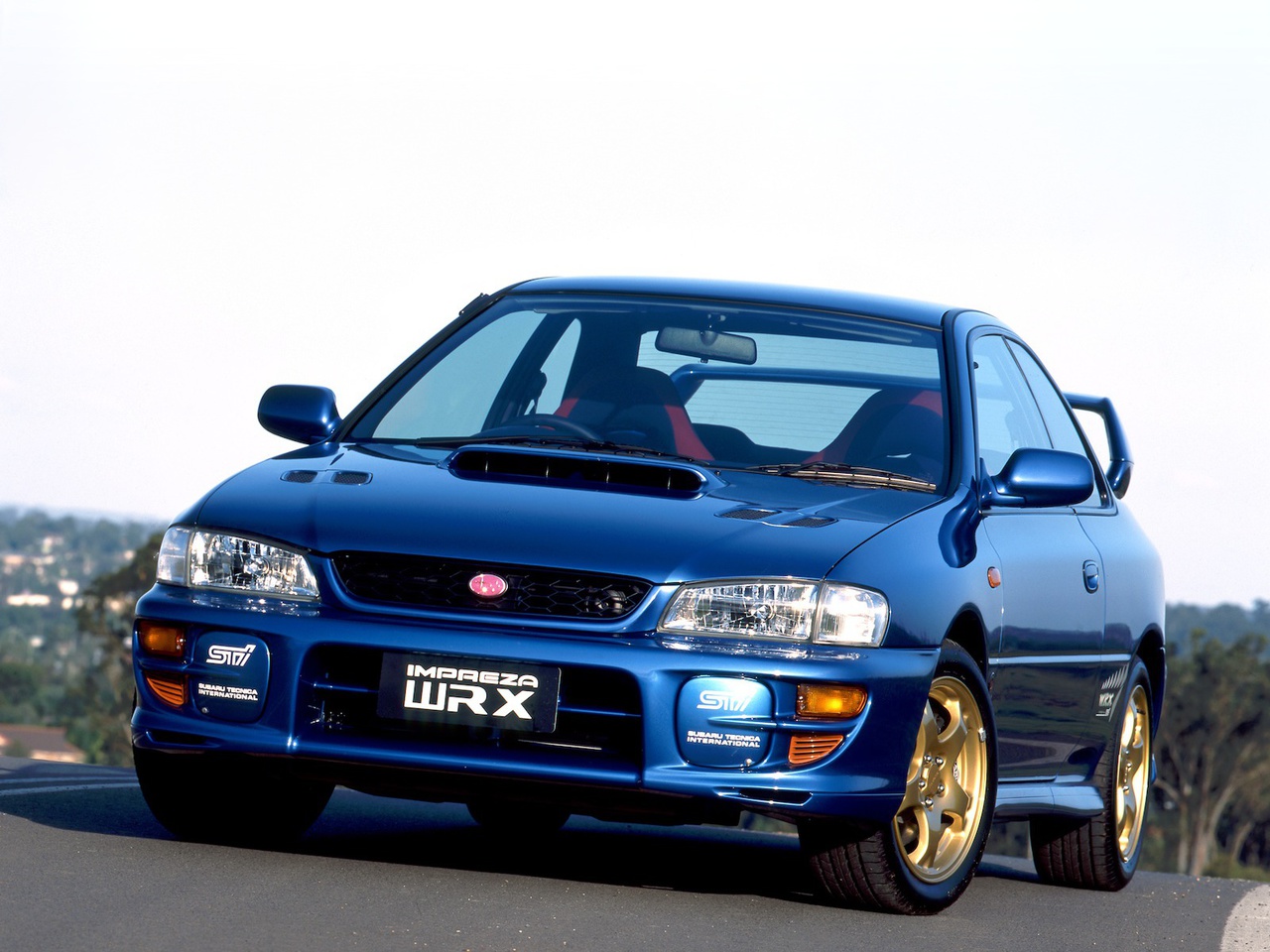Introduced in November 1993, the Impreza was offered in either front wheel drive (FWD) or all wheel drive (AWD) versions and as a four-door sedan/saloon or five-door station wagon/estate. In late 1995, a two-door coupe was introduced. The Impreza, like many Subaru-built cars, was equipped with a flat engine, a distinguishing Subaru characteristic. Initial engine choices included 1.6, 1.8 and 2.0-litre naturally-aspirated engines as well as the turbocharged and intercooled 2.0-litre engine. The basic turbocharged motor, the EJ20, produced from 240 to 280PS in Japanese market WRX trim depending on model and year. Outside Japan, the turbocharged model was initially rated at 211PS (208 hp) and marketed as the 2.0 Turbo, 2.0 GT, 2.0 GT Turbo or 2.0 WRX.
Trim levels were LX, GL and Sport. LX models were front-wheel drive, and powered by a 1.6-litre engine; these were four-door only. GL trim levels were either front-wheel drive (Subaru badged these 2WD) or all-wheel-drive (badged AWD); cars launched in 1993 had a choice of 1.6 and 1.8 engines, the 1.6 being available with 2WD, the 1.8 a AWD version only. From 1996, the 1.6 and 1.8 versions were dropped (in the European market), and replaced by a 2.0-litre engine. Sport versions had alloy wheels, and a 2.0-litre engine only. These were "warm hatch" versions which were similar to the WRX, although they looked a lot more unadorned.
In 1994, Subaru introduced Subaru Tecnica International (STi) versions of the Impreza in the Japanese Domestic Market (JDM) and European Domestic Market (EDM). These models were upgraded from the WRX in many categories, including blueprinted performance-tuned engines, transmissions, and suspensions. The STi versions of the Impreza were immensely successful in rallies and popular among street racers. The first STi models featured higher power ratings than the WRX, while later versions of both WRX and STi were rated at 280PS due to the Japanese manufacturers' informal agreements around power ratings. Its top speed was electronically limited at 198 km/h (115 mph) and it had a 0–100 km/h time of 4.9 seconds in the uk impreza turbo 218ps version. 2006 WRX STI claimed 0 to 100km 5.4 seconds.[1] RA (race altered) versions of the WRX and STi were also available in the Japanese market. Targeted for race and rally, the RA versions were generally lighter in weight; featuring reduced soundproofing, manual windows, no air conditioning, and added desirable features such as more robust engines, driver controlled center differentials, and shorter gearing.
Special editions of the Impreza were very common in Japan and Europe, many coinciding with a significant World Rally Championship victory. These editions included the Series McRae, 555, Catalunya, Terzo, RB5, P1, and 22B, the latter still considered by many to be the ultimate Impreza of all time with its wide arched rally style body.
In the same time Subaru made a limited edition of Impreza Wagon called CasaBlanca.
The Impreza received an external facelift for the 1997 model year, followed by an interior redesign in 1998 - using the new redesigned dashboard from the Forester.
The European 1999-2000 turbo model received further upgrades in the form of more parts from the STi range. The front brakes became Subaru branded 4-pot calipers with 294mm discs, the wheels having become 16 inch lightweight alloys from 1998 - previously 15 inch, vented rear discs, the Sti 4 high level wing was fitted to the saloon, Sti style front bucket seats and firmer suspension. The phase 2 engine now fitted developed 215BHP, an increase of 7BHP over the previous model.
The story of the North American Impreza is much different than the rest of the world. North American markets never received a turbocharged version of the first generation Impreza (it was heavily rumored in 1998 and 1999). Subaru had never had much of a performance image in North America, so Subaru initially offered the Impreza with the 1.8L engine only, with either front- or all-wheel drive; a 2.2-liter engine became optional in 1995. Subaru later decided to emphasize all-wheel drive, making it standard on every Impreza (and Legacy) from 1997 onwards.
However, there was a minority that knew of the Impreza's accomplishments overseas and was very interested in having a high-performance Impreza. To test the waters for a full-fledged turbo model, the 2.5RS performance model was introduced in 1998 (the same year the 1.8-liter engine was dropped). A naturally-aspirated 165 hp 2.5L DOHC engine and larger brakes, borrowed from the Legacy, were fitted into the coupe body with gold-colored 16" five-spoke wheels. The 2.5RS also featured several external cues from its overseas brethren such as hood vents, a hood scoop, and a rally-inspired rear spoiler. The 1999 model featured several changes: the newly designed "Phase II" SOHC version of the same 2.5L engine featured a slightly higher peak torque (166 ft·lbf vs. 162 ft·lbf), the wheels turned to a standard silver, the interior got an update, and US versions became visually similar to their Japanese contemporaries with an updated front bumper. 2.5RS models became available in sedan form in 2000.
The Outback Sport model was introduced in 1995 as an updated L Sport Wagon. Subaru found success with this model and that of the larger Legacy-based Outback. It offered similar ride height changes, body colors and trim levels to the larger model.
